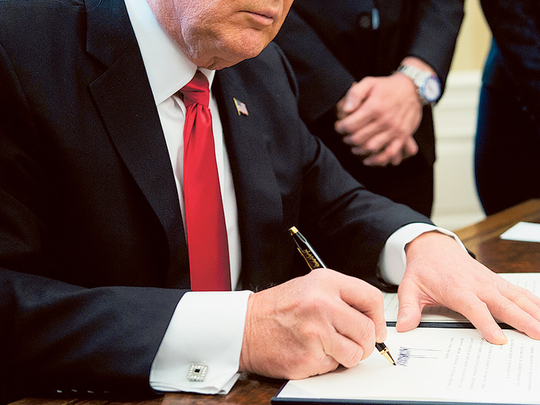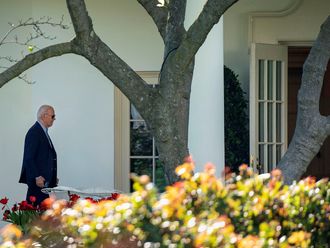
Washington: Every US president dating back to George Washington has used executive powers in some fashion or another — some more than others. Donald Trump’s predecessor Barack Obama was an avid user of his executive powers. He followed a long tradition of presidents using unilateral moves to bypass resistant lawmakers. Here are some things to know about President Trump’s unilateral moves — what they can accomplish and what they can’t.
Executive Order
An executive order is an official document signed by the president that declares government policy. In an executive order, a president is giving instructions to government agencies and departments about how to operate in a certain area. An executive order is legally binding, and written into the official journal of the government, the Federal Register. Each executive order is numbered. Executive orders cannot reverse a law passed by Congress. Limited in scope, their sweep isn’t as broad as a piece of legislation. President Trump can overturn any of President Obama’s executive orders, just as Trump’s successor can overturn anything he signs while in office.
What would this look like in real life?
President Obama used a memorandum to start the Deferred Action for Childhood Arrivals policy, which was intended to bring people brought to the US illegally as children the ability to come out of the shadows. He couldn’t give them citizenship or make them permanently legal without Congress, but he did give them a temporary legal status. President Trump could just as easily rescind this policy. It’s a two-way street between Republicans and Democrats. President Obama, for instance, in his first days in office, rolled back a ban on types of stem cell research that had been in place by an executive order of President George W. Bush.
How often are executive orders used?
The number of executive orders each president has issued varies. President Obama issued 277 executive orders during his two terms in office. George W. Bush issued 291, Bill Clinton 364, and Ronald Reagan 381. The most for any presidency was Franklin D. Roosevelt, who issued 3,721 executive orders over his twelve year tenure.
What’s the difference between an executive order and an executive action?
An executive action is a broader term, describing all types of unilateral moves by a president. That can include executive orders, but it also includes proclamations, memorandums, and proposals. Executive actions carry varying legal weight. Directives and memorandums — used to inform federal agencies of administration policy — do carry the same legal effect as an executive order, according to a Justice Department statement from 2009. But proclamations are more ceremonial, and often don’t carry legal weight. The actions are often controversial. Since the Constitution doesn’t spell out any specific terms for how and when they can be used, executive actions are ripe for legal challenges.
How are executive actions used?
President Obama utilised some of these other types of executive actions with more frequency than executive orders. Presidential memos aren’t always publicly released and they influence policy less overtly than executive orders. He used these types of memos to extend federal benefits to same-sex domestic partners, for instance. The Washington Post charted many of his actions as opposed to his orders. Trump could easily roll back some of these. He started with reversing Obama’s executive order that reversed George W. Bush’s policy. Obama’s move allowed US funding for some international groups that used non-US funding to provide abortions. Trump’s will ban it. Congress can meddle in a President’s executive authority by restricting funding for a certain programme or writing a law that explicitly prevents an executive order from taking effect. Each president also has the authority to reverse executive actions that previous commanders-in-chief have handed down.
Executive orders and actions pale in comparison to laws passed by Congress
Unlike executive actions, a law begins in Congress as a bill, is passed by both the House and Senate, and is signed by the president. Presidents have long said they prefer to govern through legislation, since laws passed by Congress can be broader in scope, and have a better chance of standing up over time (since a successive president can’t overturn them unilaterally). Laws also require many more elected officials to sign on in order for them to pass — meaning the president isn’t the sole political owner of any piece of legislation. But laws are, by design, very hard to pass. The minority party on Capitol Hill can stop almost anything it organises against. And interest groups can target lawmakers to influence their votes. It can take years of planning and lobbying to find the right moment to pass a piece of legislation. The president’s actions, while temporary and limited, can be enacted with the stroke of a pen.












